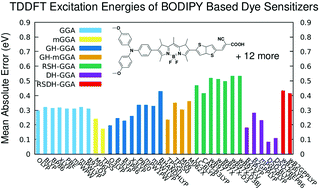Accurate predictions of the electronic excited states of BODIPY based dye sensitizers using spin-component-scaled double-hybrid functionals: a TD-DFT benchmark study†
Abstract
The vertical excitation energies of 13 BODIPY based dye sensitizers are benchmarked by means of TD-DFT, using 36 functionals from different DFT rungs. Most TD-DFT results were found to overestimate the excitation energies, and show mean absolute error (MAE) values in the range 0.2–0.5 eV. The dispersion-corrected, spin-component-scaled, double-hybrid (DSD) functionals DSD-BLYP and DSD-PBEP86 were found to have the smallest MAE values of 0.083 eV and 0.106 eV, respectively, which is close to the range of average errors found in the more expensive coupled-cluster methods. Moreover, DSD-BLYP and DSD-PBEP86 functionals show excellent consistency and quality of results (standard deviation = 0.048 eV and 0.069 eV respectively). However, the range separated hybrid (RSH) and the range separated double hybrid (RSDH) functionals were found to provide the best predictability (linear determination coefficient R2 > 0.97 eV).



 Please wait while we load your content...
Please wait while we load your content...